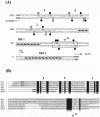DNA binding activity of the Escherichia coli nitric oxide sensor NorR suggests a conserved target sequence in diverse proteobacteria
- PMID: 15375149
- PMCID: PMC516610
- DOI: 10.1128/JB.186.19.6656-6660.2004
DNA binding activity of the Escherichia coli nitric oxide sensor NorR suggests a conserved target sequence in diverse proteobacteria
Abstract
The Escherichia coli nitric oxide sensor NorR was shown to bind to the promoter region of the norVW transcription unit, forming at least two distinct complexes detectable by gel retardation. Three binding sites for NorR and two integration host factor binding sites were identified in the norR-norV intergenic region. The derived consensus sequence for NorR binding sites was used to search for novel members of the E. coli NorR regulon and to show that NorR binding sites are partially conserved in other members of the proteobacteria.
Figures






Similar articles
-
Mechanism of transcriptional regulation by the Escherichia coli nitric oxide sensor NorR.Biochem Soc Trans. 2006 Feb;34(Pt 1):191-4. doi: 10.1042/BST0340191. Biochem Soc Trans. 2006. PMID: 16417519 Review.
-
DNA binding properties of the Escherichia coli nitric oxide sensor NorR: towards an understanding of the regulation of flavorubredoxin expression.Biochem Soc Trans. 2005 Feb;33(Pt 1):181-3. doi: 10.1042/BST0330181. Biochem Soc Trans. 2005. PMID: 15667300
-
Transcriptional regulation by the dedicated nitric oxide sensor, NorR: a route towards NO detoxification.Biochem Soc Trans. 2011 Jan;39(1):289-93. doi: 10.1042/BST0390289. Biochem Soc Trans. 2011. PMID: 21265790 Review.
-
A DNA region recognized by the nitric oxide-responsive transcriptional activator NorR is conserved in beta- and gamma-proteobacteria.J Bacteriol. 2004 Dec;186(23):7980-7. doi: 10.1128/JB.186.23.7980-7987.2004. J Bacteriol. 2004. PMID: 15547270 Free PMC article.
-
Regulation of the nitric oxide reduction operon (norRVW) in Escherichia coli. Role of NorR and sigma54 in the nitric oxide stress response.J Biol Chem. 2003 Mar 21;278(12):10081-6. doi: 10.1074/jbc.M212462200. Epub 2003 Jan 15. J Biol Chem. 2003. PMID: 12529359
Cited by
-
Cooperative Roles of Nitric Oxide-Metabolizing Enzymes To Counteract Nitrosative Stress in Enterohemorrhagic Escherichia coli.Infect Immun. 2019 Aug 21;87(9):e00334-19. doi: 10.1128/IAI.00334-19. Print 2019 Sep. Infect Immun. 2019. PMID: 31209149 Free PMC article.
-
Modulating Salmonella Typhimurium's Response to a Changing Environment through Bacterial Enhancer-Binding Proteins and the RpoN Regulon.Front Mol Biosci. 2016 Aug 17;3:41. doi: 10.3389/fmolb.2016.00041. eCollection 2016. Front Mol Biosci. 2016. PMID: 27583250 Free PMC article. Review.
-
Desulfovibrio gigas flavodiiron protein affords protection against nitrosative stress in vivo.J Bacteriol. 2006 Apr;188(8):2745-51. doi: 10.1128/JB.188.8.2745-2751.2006. J Bacteriol. 2006. PMID: 16585735 Free PMC article.
-
Essential roles of three enhancer sites in sigma54-dependent transcription by the nitric oxide sensing regulatory protein NorR.Nucleic Acids Res. 2010 Mar;38(4):1182-94. doi: 10.1093/nar/gkp1065. Epub 2009 Dec 2. Nucleic Acids Res. 2010. PMID: 19955233 Free PMC article.
-
Transcriptional regulation of the flavohemoglobin gene for aerobic nitric oxide detoxification by the second nitric oxide-responsive regulator of Pseudomonas aeruginosa.J Bacteriol. 2005 Jun;187(12):3960-8. doi: 10.1128/JB.187.12.3960-3968.2005. J Bacteriol. 2005. PMID: 15937158 Free PMC article.
References
-
- Buck, M., and W. Cannon. 1992. Specific binding of the transcription factor sigma-54 to promoter DNA. Nature 358:422-424. - PubMed
-
- Da Costa, P. N., M. Teixeira, and L. M. Saraiva. 2003. Regulation of the flavorubredoxin nitric oxide reductase gene in Escherichia coli: nitrate repression, nitrite induction, and possible post-transcription control. FEMS Microbiol. Lett. 218:385-393. - PubMed
Publication types
MeSH terms
Substances
Grants and funding
LinkOut - more resources
Full Text Sources
Molecular Biology Databases

